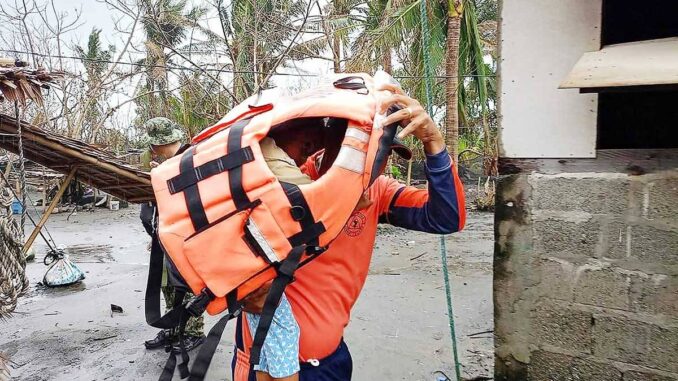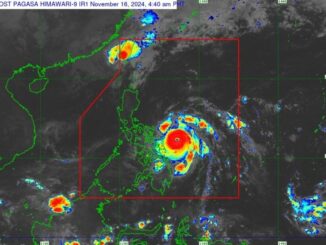
TYPHOON Ofel (international name: Usagi) slammed into the country’s already disaster-ravaged north on Thursday, as authorities rushed to evacuate thousands of people from coastal areas.
Ofel made landfall in the town of Baggao in Cagayan province at 1:30 p.m. with winds of 175 kilometers an hour, the national weather service said — the fifth storm to strike the country in just three weeks.
The brutal wave of weather disasters has already killed 159 people and prompted the United Nations to request $32.9 million in aid for the worst-affected regions.
TO SAFETY This handout photo taken on Nov. 14, 2024 and released by Buguey Municipal Disaster Risk and Reduction Management Office via Cagayan Provincial Public
Information Office shows a rescuer carrying a young resident during a forced evacuation operation in Buguey town, Cagayan province, ahead of Super Typhoon Ofel’s landfall.
AFP PHOTO/BUGUEY MUNICIPAL DISASTER RISK AND REDUCTION MANAGEMENT OFFICE VIA CAGAYAN PROVINCIAL PUBLIC INFORMATION OFFICE
The national weather agency had initially raised its highest storm alert, but downgraded to its second-highest as Ofel made landfall.
It said the winds could cause “considerable damage to structures of light materials,” moderate damage even to structures otherwise considered “low-risk,” and uproot large trees within the next 12 hours.

The Philippine Atmospheric Geophysical Astronomical Services Administration (Pagasa) shows the latest movement of Super Typhoon ‘Ofel,’ along with two other tropical storms around the Philippine Area of Responsibility on Nov. 14, 2024 at its headquarters in Quezon City. PHOTO BY ISMAEL DE JUAN

The Philippine Atmospheric Geophysical Astronomical Services Administration (Pagasa) shows the latest movement of Super Typhoon ‘Ofel,’ along with two other tropical storms around the Philippine Area of Responsibility on Nov. 14, 2024 at its headquarters in Quezon City. PHOTO BY ISMAEL DE JUAN

The Philippine Atmospheric Geophysical Astronomical Services Administration (Pagasa) shows the latest movement of Super Typhoon ‘Ofel,’ along with two other tropical storms around the Philippine Area of Responsibility on Nov. 14, 2024 at its headquarters in Quezon City. PHOTO BY ISMAEL DE JUAN

The Philippine Atmospheric Geophysical Astronomical Services Administration (Pagasa) shows the latest movement of Super Typhoon ‘Ofel,’ along with two other tropical storms around the Philippine Area of Responsibility on Nov. 14, 2024 at its headquarters in Quezon City. PHOTO BY ISMAEL DE JUAN
“Intense to torrential rain” and potentially “life-threatening” coastal waves of up to three meters (nine feet) were also forecast over two days.
Moving west-northwestward at 20 kilometers per hour (kph), Ofel was in the vicinity of Gonzaga, Cagayan or Isca, Cagayan while packing maximum sustained winds of 165 kph near the center and gustiness of up to 275 kph, the weather agency said.
In its 5 p.m. bulletin, the Philippine Atmospheric, Geophysical and Astronomical Services Administration (Pagasa) said Signal No. 4 remains up over Babuyan Islands and the northern and eastern portions of mainland Cagayan.
Signal No. 3 was raised over Batanes, the rest of Cagayan, the northern portion of Isabela, the northern portion of Apayao, and the northern portion of Ilocos Norte.
Signal No. 2 was hoisted over the western and eastern portions of Isabela, the rest of Apayao, Kalinga, the northeastern portion of Abra, the eastern portion of Mountain Province, and the rest of Ilocos Norte.
The rest of Isabela, Quirino, the northern portion of Nueva Vizcaya, the rest of Mountain Province, the rest of Ifugao, the rest of Abra, the northern portion of Benguet, Ilocos Sur, the northern portion of La Union, and the northern portion of Aurora were still under Signal No. 1.
President Ferdinand Marcos Jr., visiting storm-affected areas to dole out emergency cash assistance, urged residents to comply with evacuation orders.
“We know that it is difficult to leave your homes and possessions, but sheltering could save lives,” he told residents of Mindoro island.
“While we cannot prevent typhoons from hitting the country, we can take steps to reduce their impact,” he said, calling for better infrastructure to cope with worsening storm effects he blamed on climate change.
Marcos on Thursday distributed P42.33 million in financial assistance to farmers, fishers and families affected by Severe Tropical Storm Kristine and Super Typhoon Leon in Cavite.
A total of 4,233 beneficiaries from 21 municipalities in the province received P10,000 each.
In his speech during the aid distribution at the Tagaytay International Convention Center, Marcos promised to help victims of Kristine and Leon recover from their impacts as soon as possible.
“We continue to work hard to help Caviteños return to their normal lives, as well as those in neighboring provinces of Calabarzon,” Marcos said.
The President said the Department of Social Welfare and Development and the Department of Labor and Employment were present during the event to help provide help.
Marcos also urged Caviteños to remain resolute and hopeful in the face of challenges as he assured them of continued government support.
“I encourage you all to stay strong, work together, and never lose hope, because the government is with you every step of the way in your recovery,” Marcos said.
As of Tuesday, Nov. 12, over 66,700 families in Cavite were reported affected by the combined effects of Kristine and Leon. The figure translates to over 261,000 affected individuals.
Forced evacuations
In Cagayan, officials worked in driving rain Thursday to evacuate residents along the coasts and on the banks of already swollen rivers.
“Yesterday it was preemptive evacuations. Now we’re doing forced evacuations,” local disaster official Edward Gaspar said by phone hours before landfall, adding 1,404 residents were sheltering at a municipal gym.
“There are many more evacuees in nearby villages but we haven’t had time to visit and count them,” he added.
Cagayan’s civil defense chief Rueli Rapsing said he expected local governments to take 40,000 people to shelters, roughly the same number that were preemptively evacuated ahead of Typhoon Marce, which struck Cagayan’s north coast earlier this month.
More than 5,000 Cagayan residents were still in shelters following the previous storms because the Cagayan river, the country’s largest, remained swollen from heavy rain that fell in several provinces upstream.
“We expect this situation to persist over the next few days” as Ofel brings more rain, Rapsing said.
Overlapping typhoons
After Usagi, Tropical Storm Pepito is also forecast to strike the Philippines’ population heartland around Manila this weekend.
A high-pressure area in southern Japan will cause the storm to follow a more southerly track than Ofel, the weather service said.
“Typhoons are overlapping. As soon as communities attempt to recover from the shock, the next tropical storm is already hitting them again,” UN Philippines Resident and Humanitarian Coordinator Gustavo Gonzalez said.
“In this context, the response capacity gets exhausted and budgets depleted.”
A UN assessment of the past month’s weather disasters said 207,000 houses had been damaged or destroyed, and nearly 700,000 people were seeking temporary shelter.
Many families were without even essentials like sleeping mats, hygiene kits, and cooking supplies, and had limited access to safe drinking water, it said.
The storms destroyed thousands of hectares of farmland and persistent flooding is likely to delay replanting efforts and worsen food supply problems, the report added.
The Philippine Air Force (PAF) on Thursday conducted emergency aerial relief operations in typhoon-devastated communities in Northern Luzon ahead of Ofel.
The PAF along with policemen and army troops unloaded about 1,000 food packs and other relief supplies from Black Hawk helicopters in Calayan, Cagayan. Air Force Public Affairs chief Col. Ma Consuelo Castillo said helicopters from the Tactical Operations Wing Northern Luzon delivered boxes of relief supplies from the Department of Social Welfare and Development (DSWD).
The PAF’s C130 aircraft also performed multiple sorties in the past few days to transport relief packs to Basco, Batanes, that will also benefit other communities in the northernmost islands of Itbayat and Sabtang.
Also on Thursday, Sen. Imee Marcos pressed for an improved disaster preparedness plan as four typhoons — Marce, Nika, Ofel, and Pepito — are expected to hit northern Luzon this week.
The senator made the appeal during the commemoration of the 11th anniversary of Super Typhoon Yolanda which killed over 6,000.
She raised the need for an immediate national climate strategy and stronger disaster preparedness. “Now more than ever, we’re on our own,” she said. “Every year, we’re battered by storms and floods. If we don’t take action now, we will all remain at risk. Three to five typhoons are still to come. There’s still time to climate-adapt our homes, at least to some extent,” Marcos said.
In a statement, she said that the string of storms highlighted the country’s struggle with severe weather and flooding, which demand immediate attention.
“While the rest of the world also struggles with climate change, and experts are willing to help us, we can only count on our own volition and action to adapt to this new normal,” Marcos said.
AFP, ARLIE O. CALALO, CATHERINE S. VALENTE, FRANCISCO TUYAY, BERNADETTE E. TAMAYO







Be the first to comment